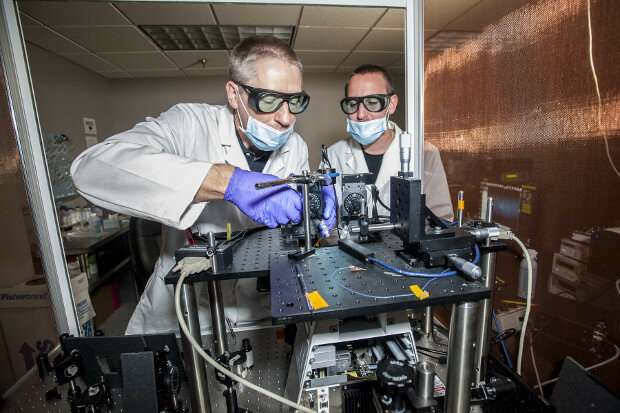How 'optical tweezers' could address one of crime labs' biggest challenges

When potential DNA evidence—say, from a sexual assault case—is submitted to a forensic lab for analysis, the scientists are often faced with the time-consuming challenge of sorting out which DNA profile came from the victim and which came from the criminal.
"Forensic scientists have to spend a lot of time on the back end of the analysis portion trying to deconvolute which DNA profile came from which person at each genetic locus," said Tracey Dawson Cruz, Ph.D., associate professor and chair of the Department of Forensic Science in the Virginia Commonwealth University College of Humanities and Sciences. "This has been historically one of the most challenging problems in forensic DNA."
A new process being developed by VCU forensic science and physics researchers might make the process easier.
Dawson Cruz, along with Sarah Seashols-Williams, Ph.D., assistant professor of forensic science, and Joseph Reiner, Ph.D., associate professor in the Department of Physics, have found that an "optical tweezer"— a compact, strongly focused laser beam that uses an immersion objective lens on an inverted microscope to create an optical trap—is effective at separating mixed cells, such as sperm and vaginal cells, within a solution.
"In sex assault case work, you'll often have sperm cells mixed with many other cell types," Reiner said. "It's easy to identify a sperm cell under a microscope. So we take our laser tweezers and use them to pick out the sperm cells and isolate them from the other cell types. After this, we can extract them for DNA analysis."
The team has authored a paper, "Optical tweezers as an effective tool for spermatozoa isolation from mixed forensic samples," that demonstrates how the process works and shows that crime labs can obtain a consistently full DNA profile from just 50 tweezed sperm cells. The paper will be published in a forthcoming issue of the journal PLOS One.
"Because [the process] is manual, it is really important that we set the number of individual cells that have to be tweezed out of the mixture. Because if that is very high, then it could be time prohibitive, it could be too lengthy of a process for a lab to want to take on," Dawson Cruz said. "So the finding of only needing 50 sperm cells is pretty good."
Previous research that used optical tweezers on forensic samples was conducted a decade ago, and in that case 500 sperm cells were needed to develop a full profile.
"The field has improved dramatically in terms of sensitivity," Seashols-Williams said. "That's why we felt this is such an interesting project. The increased sensitivity really makes optical tweezers more viable now than they were 10 years ago."
The team also demonstrated that a complete, single-source DNA profile was achieved by isolating sperm cells via optical trapping from a mixture of sperm and vaginal epithelial cells.
"Based on these results, optical tweezers are a viable option for forensic applications such as separation of mixed populations of cells in forensic evidence," the team wrote in the paper.
Now that the team has demonstrated that the process works, their next goal is to couple it to a microchip device that would allow forensic science labs to apply it easily to their day-to-day work analyzing DNA evidence.
"We've already shown proof of concept that you can separate out these cells," Seashols-Williams said. "If it's simplified, I think labs would be amenable to implementing it. Our challenges right now are transferring the cells into the DNA workflow. That's why we want this all-in-one device so it's simplified and so we won't lose cells in the transfer."
The team also is planning to apply optical tweezers to forensic evidence beyond sperm and vaginal epithelial cells.
"We're expanding the project to look at cells of other morphologies," Seashols-Williams said. "You probably know that red blood cells don't have DNA. They don't have a nucleus. So the major source of your DNA in blood is white blood cells. When we're looking at a blood sample mixed with touch cells or vaginal cells, for us to be able to pull the white blood cells out and isolate them from the other components also could be very useful.
"So we think we can expand the types of cells that optical tweezers can be used for," she said.
Journal information: PLoS ONE
Provided by Virginia Commonwealth University





















